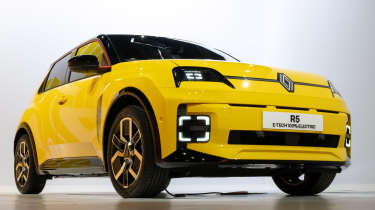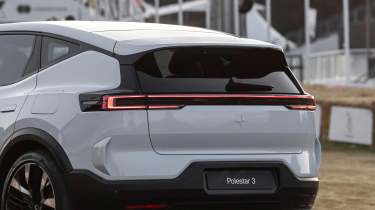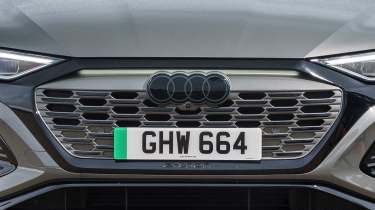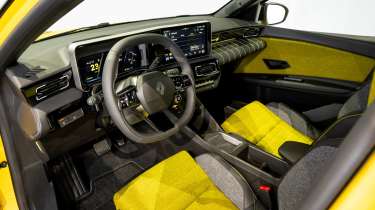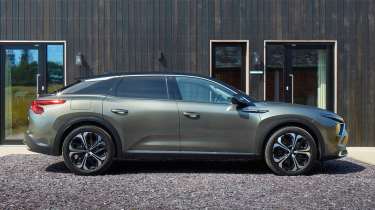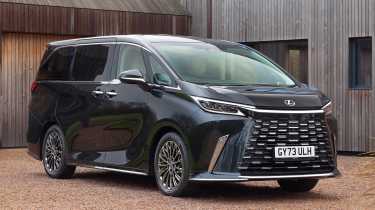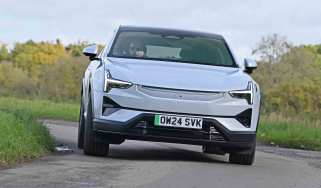6 big design trends shaping cars of today and tomorrow
Aysar Ghassan, programme director of the Automotive and Transport Design course at Coventry University, talks us through today’s top trends in styling
Car designers work at the cutting edge of the industry. The talented individuals in studios worldwide never stop sketching and playing with shapes and proportions, as well as experimenting with new materials and different colours.
But as in the fashion industry, the very best ideas can soon become a trend. It’s a cyclic business, but there are often times when a stance or a styling feature turns up on multiple vehicles.
It’s a fine line for designers to walk, because no manufacturer wants its cars to look dated if they don’t keep up with the movement of the moment. Equally, no one will just follow the herd, because there’s always a risk that as it gathers pace, cars end up looking too similar.
Aysar Ghassan is an expert in the field, via his position at the helm of Coventry University’s world-renowned automotive design programme. Here he talks us through six of the top trends in car design today – some of them already commonplace, others just starting to make an impact, and one that has yet to reach us. All of them show how car companies use design to keep us buying fresh metal.
Premium plastic trim
“SUVs are bulky and can look very heavy, so designers have developed clever tricks to make them seem a little lighter. Dark grey plastic trim around the wheelarches, door sills and bumpers is a go-to way of hiding some of these vehicles’ bulk. Usually, this has a light texture, a lustrous finish, and resembles the kind of material that you would find on the dashboard of a van, so it doesn’t give off a particularly premium feeling.
“A new generation of SUVs – including the Alfa Romeo Tonale and the Peugeot E-3008 – use glossy black plastic for these areas. This shows off reflections and highlights, so it looks really slick and gives a more refined, premium edge. But this trend isn’t confined to SUVs. Glossy black wheelarch trims on superminis like the Peugeot 208 and E-208 add some extra pizazz.
“This type of black trim also features on the recently revealed Renault 5 E-Tech, the spiritual successor to the French company’s iconic hatchback of the seventies, eighties and nineties. Renault says that the overall design will remain pretty much unchanged for around 15 years, and that instead of drastic facelifts, the car will undergo a series of minor styling updates.
“Using such glossy black features is a masterstroke, because it helps make the new 5 look bang up to date. But these trims will be easy to replace with whichever material or finish is trending in a few years’ time.
Full-width front and rear lights
“Low, wide cars look better than tall, narrow ones. But not every car can be a Lamborghini, so designers try to make family cars look as low and wide as possible.
“Over the years, these models have grown in height: the current Volkswagen Golf is around 10cm taller than the first-generation model, for example. To make up for this, cars have become wider, making them look more sure-footed; today’s Golf is around 18cm wider than the original. Not content with this, some cars also have full-width LED lights – especially at the rear. This is because narrow, horizontally arranged lights make us look from side to side instead of up and down, tricking us into thinking that cars are wider – and lower – than they are.
“The trouble is that all horizontal light strips can look very similar, and don’t help customers tell brands apart, especially at night. So, designers add clever touches to help us do just that. Little fins on both ends of the Audi Q8 e-tron’s rear light do a great job of this, while right angles on the Polestar 3’s rear light create a geometric look that echoes the sharp design of the body.
“But it’s not only SUVs that have horizontal light strips. At just 1.4 metres high, the Audi e-tron GT quattro will never look wobbly, but its segmented rear light strip makes it appear wider and lower still, giving it an even more commanding stance, which can’t be a bad thing.”
The ‘non-grille’ front grille
“Front-engined cars have always needed a grille to feed the radiator with cooling air. But more than that, the front grille helps customers tell brands apart; after all, we all know a BMW when we see one. Because of this, car designers spend a lot of their time thinking about how the front grille should look.
“Unlike cars with an internal-combustion engine, Electric cars don’t need a large front grille, so car manufacturers are experimenting with what they can do in that area. Removing the grille risks having a large blank section right in the middle of the car’s ‘face’, which is not necessarily a good idea. As a result, many companies have retained a shape that resembles a grille and played with different surface finishes and colours.
“The gloss-black ‘non-grille grille’ of the Mercedes EQ series shows off reflections and highlights that help to break up this sizeable area. Peugeot has opted for attention-grabbing explosions of colour and texture on the grilles of the E-208 and E-3008, reflecting the French brand’s vibrant image and ultra-sporty design language. Audi too has experimented with textured grilles, and the light grey colour on the grilles of the Q4 e-tron and e-tron GT quattro delivers a high-end look.
“Interestingly, the grilles of the Audi Q8 e-tron and e-tron Sportback both have a mesh-like design – and hexagonal holes – behind which there’s a dark panel. This set-up allows the car to have a more traditional look that may calm those of us who weep at the inevitable demise of traditional fossil-fuelled engines.”
More exciting interior colour and trim
“Luxury car interiors feature high-quality materials and combine different colours and textures to create a particular look and feel. To save on costs, the colour and fabric choices in regular family cars are more limited. As infotainment screens, multi-speaker sound systems and attention-grabbing ambient lighting have become commonplace in more affordable cars, mainstream manufacturers are looking for new ways to entice customers to step inside their designs.
“With less freedom to work with, designers do their best to jazz up greyish seats with textures, segmented padding and, when let loose, the occasional splash of colour. Door trims are also usually grey, sometimes with a metallic finish on details like handles to create a bit of glamour. Thankfully, the Fiat 500 and the Smart range have shown this doesn’t always have to be the way. We’re not surrounded by grey-coloured rooms at home – and increasingly in offices – so why should we have to put up with such sombre tones in our cars?
“The seats on the recently revealed Citroen e-C3 are black and white, coordinating with the door trims and dashboard to create a holistic and modern atmosphere. The Renault 5 E-Tech takes the fight against greyness a step further. The ‘Iconic Cinq’ trim option gives you seats with yellow padding that matches the front door trim and stitching on the dash. Many concept cars are following this trend for more interesting and integrated colours and materials, so the days of dull interiors in more affordable cars may well be numbered.”
Fusion cars
“What if designers could take the best bits of existing types of cars and combine them into one? That’s just what many are trying to do, and they’re creating a fresh type of car in the process. This new species has the bold, muscular impact of an SUV, but is far lower and more streamlined than a traditional ‘Chelsea tractor’. It also combines a sporty silhouette with the practicality of a hatchback. What’s the name of this new type of car? We might call them crossovers, but they’ve been around a while. And although I never really know what they are, let’s just call them ‘fusion cars’.
“The Kia EV6 and Citroen C5 X are great examples of the breed. Launched in 2021, the EV6 hasn’t aged. Its brawny proportions and space-age rear light design still make it look like a concept car that’s snuck on to our roads. It’s also surprisingly practical. Though almost 50cm shorter than the standard Audi A8, the EV6 has a longer wheelbase, giving it a surprisingly roomy cabin. The Citroen C5 X is very practical, too. It’s virtually as long as a BMW 3 Series saloon, but its coupé-style rear end gives the petrol version an extra 65 litres of boot space. Plus, its seats are a little higher than those in the BMW, making the Citroen easier to get in and out of.
“With buyers demanding more practicality, we might even see fusion cars (Citroen calls them ‘hatchbacks’, but I’m not convinced) beginning to replace saloons.”
Future trend: The return of the MPV?
“With the BMW XM being the latest to join the five-metre-plus luxury SUV club, it could seem that the rise of the behemoth off-roader knows no bounds. But this might not actually be the case.
“Manufacturers are launching enormous luxury cars with the commanding seating position of SUVs, but that don’t rely on go-anywhere-styling. Designers are revisiting a type of car that was popular before SUVs became ubiquitous: the Multi-person Vehicle (MPV).
“For years, the Mercedes V-Class (and more recently the EQV) were the only serious players in this segment in the UK and Europe, but a new generation of cars is set to ignite the high-end MPV market. Lexus’ brand-new flagship LM starts at nearly £90K and has a ‘one box’ silhouette like MPVs of the 1990s and early 2000s.
“The LM wouldn’t dream of going off road, so it avoids the knuckle-shaped arches, bumpers and sills of an SUV. But it’s no shrinking violet; its design has a dramatic presence to reflect its mission: to create an opulent environment for affluent people while owning the road. Volvo’s recently revealed EM90 and LEVC’s L380 have joined the fired-up super-luxury MPV fray, but for now at least, they will only be available in China.
“Is this the beginning of the end for the T-Rex SUV? Surely not. But we may well see more manufacturers diversifying their line-ups. Perhaps MPVs will make a comeback in the less luxurious end of the market too.”
What do you think will be the next big car design trend? Let us know in the comments section...
Find a car with the experts



